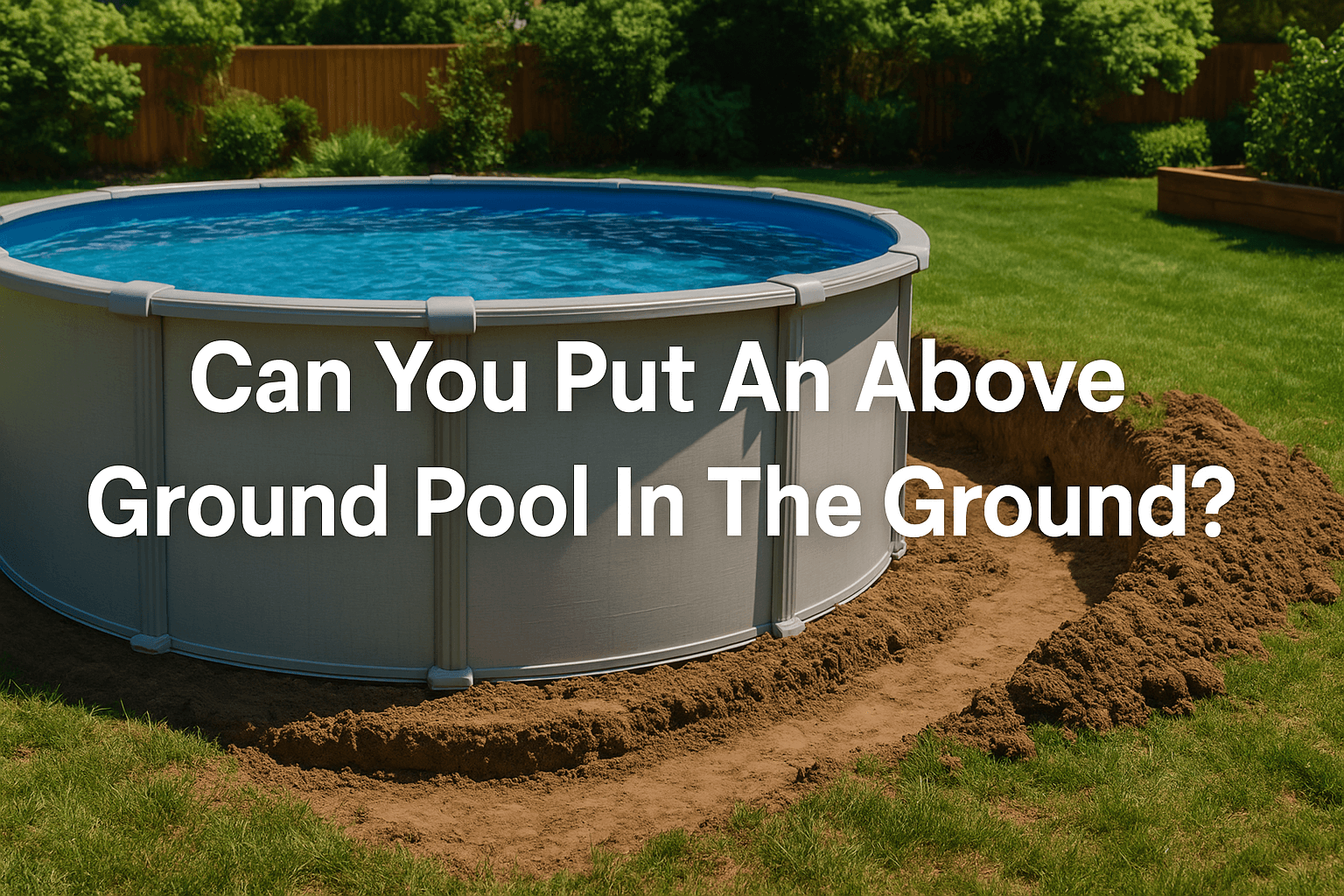
Can You Put An Above Ground Pool In The Ground?
Thought about sinking your above ground pool into the ground for that sleek, in-ground look—without the in-ground price tag? The short answer: yes, you can! From drainage hacks to supporting deep above ground pools, we’ll show you how to do it safely, beautifully, and without burying your budget.
Exploring the Concept of "Semi-Inground" Pools
What it Means to Bury an Above Ground Pool (Partial vs. Full Burial)
Can you bury an above ground pool? You bet. But there’s a difference between dropping it halfway into the ground and going full submarine. Partial burial—also called semi-inground—means the pool walls are partially below ground level. Full burial? That’s when the pool is completely sunken in, like a traditional in-ground one. Each comes with its own set of rules, risks, and rewards.
Why Pool Owners Choose This Option (Aesthetics, Easier Access, Stability)
So why go semi-inground? For starters, it looks miles better. It blends right into your garden design and makes for a more stylish outdoor space. It also makes getting in and out easier—especially handy for little ones or older swimmers. Plus, a partially buried pool has extra support from the surrounding soil, making it feel sturdier all around.
Key Differences from Traditional In-Ground Pools
Don't be fooled by appearances—these pools may look similar, but they're not built the same. Traditional in-ground pools are designed to handle pressure from all directions. Most above ground pools aren't. That’s why proper reinforcement is a must if you’re thinking of going underground.

The Feasibility: Can Above Ground Pools Be Buried?
Yes, Many Models Are Suitable with Proper Preparation
Not every pool is up for the challenge. But many modern above ground pools—especially those with steel or resin frames—can handle a semi or full burial. What matters most? Preparation. You’ll need the right pool, solid ground, and a smart installation plan.
Manufacturer Guidelines and Warranty Considerations
Here’s the catch—bury your pool without following the manufacturer’s advice, and you could kiss your warranty goodbye. Always check the small print before you dig. Some brands give the green light, others don’t. It's better to be safe than sorry (and out of pocket).
Importance of Engineered Design for Burial
Pools that are going underground need to be engineered to cope with pressure from soil and water. If it’s not built for it, don’t risk it. Crushed walls or leaks are not the summer vibes anyone wants. Look for models with reinforced frames and get advice from the pros.
What Above Ground Pools Can Be Buried? Suitability by Type
Which Above Ground Pools Can Be Partially Buried?
Steel Wall Pools (Often Requires Specific Wall Coatings or Protective Measures)
Steel wall pools are strong—but they're not invincible. If you're partially burying one, it might need a protective coating to stop rust and corrosion. Think of it like armour for your pool. Get this right and your pool will last years underground.
Resin Frame Pools (Highly Resistant to Corrosion, Good for Burial)
Resin is a game changer. It’s super resistant to corrosion and doesn’t flinch at a bit of damp soil. These pools are a top choice for going semi-inground. Just be sure the ground around it is well-drained.
Aluminium Frame Pools (Corrosion-Resistant, Suitable for Burial)
Aluminium pools are another smart option. They’re naturally rust-resistant and lightweight. Easy to handle and solid once installed. Great if you're after a sleek look without the hassle.
Which Above Ground Pools Can Be Fully Buried?
Specialised "On-Ground" or "Hybrid" Pools Designed for Full Burial
If you want to go all-in—literally—look for "on-ground" or "hybrid" pools. These are built tough and meant to live underground full-time. They often mimic in-ground pool performance, minus the hefty price tag.
Models with Reinforced Walls and Frames for Earth Pressure
A fully buried pool faces serious pressure from the surrounding earth. That’s why reinforced walls are a must. Look for models that shout about their strength—these are built to last, even when buried deep.
Manufacturer Certification for Full Burial
Before you grab a shovel, make sure your chosen pool is certified for full burial. If it’s not officially approved, it’s not worth the risk. Certification means it’s been tested and built to handle underground life.

Can Above Ground Pools Be Put in the Ground? Installation & Considerations
Crucial Site Preparation and Excavation
Digging the Hole and Ensuring Proper Dimensions
First things first: dig smart. Make sure the hole is wide and deep enough to fit the pool and allow for backfill. Watch out for tree roots, pipes, and underground surprises. Planning ahead here can save a world of headaches later.
Creating a Stable, Level Base for the Pool
Your base is everything. Use compacted sand or gravel to form a solid, level foundation. Skip this step and you risk an uneven pool—or worse, a collapse.
Addressing Soil Conditions and Backfill Requirements
Different soils behave differently. Sandy soil drains well but might shift. Clay holds moisture and can swell. The key is choosing the right backfill—gravel mixes often work best. Ask a local builder or landscaper if you're unsure.
Managing Drainage Effectively
Preventing Water Accumulation Around the Buried Walls
Water and pools go hand in hand—but only on the inside. Let water build up around the outside, and you’re in trouble. Proper drainage stops water from seeping in, damaging the structure, or turning your pool into a muddy moat.
Installing Perimeter Drains or Sump Pumps (If Necessary)
If your garden tends to hold water, it’s worth installing a perimeter drain or sump pump. These systems reroute water safely away. Here’s a quick look:
| Drainage Solution | Waterproofing Measure | Benefits |
|---|---|---|
| French Drain | Waterproof Coating | Keeps moisture away, prevents damage |
| Sump Pump | Sealant Application | Moves water fast, long-term protection |

Structural Integrity and Support
Protecting Pool Walls from External Pressure (Backfill Material)
Once the pool’s in, the walls need to be supported properly. The wrong backfill can cause bowing or collapse. Gravel and compacted fill help spread the pressure evenly. Don't cut corners—this bit matters.
Ensuring Proper Bracing and Support Systems
You may need extra bracing depending on the pool’s design. Some installers use timber framing, others rely on reinforced panels. If you’re unsure, bring in a pro to check your setup.
Permits, Regulations, and Costs
Increased Likelihood of Needing Building Permits
In the UK, burying a pool might mean applying for planning permission. Each council’s different, so always check before you start. It could be a quick yes—or a long process.
Higher Installation Costs Compared to Standard Above-Ground Setup
Going underground isn’t cheap. You’ll need excavation, drainage, and possibly extra materials. But it still comes in lower than a full-blown in-ground pool. Budget for it and weigh up whether the look is worth the spend.
Impact on Future Portability of the Pool
One final thing—once it’s buried, it’s not going anywhere. Above ground pools are usually easy to move or upgrade. That flexibility’s gone once it’s in the ground, so make sure it’s your forever spot.
Final Thoughts
So, can you put an above ground pool in the ground? Absolutely. And when done right, it can turn a standard setup into a standout garden feature.
Whether you go halfway or all in, it’s about planning, prep, and picking the right pool. And if you’re unsure, don’t go it alone—getting advice from a pro could save your summer (and your wallet).
Have you checked out our other posts?
Can Above Ground Pools Be Put On Concrete?
Can Above Ground Pools Be Moved?
Does An Above Ground Pool Need A Pump?


Leave a comment